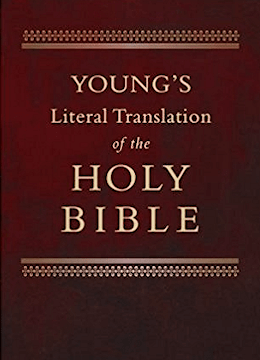Textus Receptus Bibles
Young's Literal Translation 1862
| 10:1 | And I look, and lo, on the expanse that `is' above the head of the cherubs, as a sapphire stone, as the appearance of the likeness of a throne, He hath been seen over them. |
| 10:2 | And He speaketh unto the man clothed with linen, and saith, `Go in unto the midst of the wheel, unto the place of the cherub, and fill thy hands with coals of fire from between the cherubs, and scatter over the city.' And he goeth in before mine eyes. |
| 10:3 | And the cherubs are standing on the right side of the house, at the going in of the man, and the cloud hath filled the inner court, |
| 10:4 | and become high doth the honour of Jehovah above the cherub, over the threshold of the house, and the house is filled with the cloud, and the court hath been filled with the brightness of the honour of Jehovah. |
| 10:5 | And a noise of the wings of the cherubs hath been heard unto the outer court, as the voice of God -- the Mighty One -- in His speaking. |
| 10:6 | And it cometh to pass, in His commanding the man clothed with linen, saying, `Take fire from between the wheel, from between the cherubs,' and he goeth in and standeth near the wheel, |
| 10:7 | that the `one' cherub putteth forth his hand from between the cherubs unto the fire that `is' between the cherubs, and lifteth up, and giveth into the hands of him who is clothed with linen, and he receiveth, and cometh forth. |
| 10:8 | And there appeareth in the cherubs the form of a hand of man under their wings, |
| 10:9 | and I look, and lo, four wheels near the cherubs, one wheel near the one cherub, and another wheel near the other cherub, and the appearance of the wheels `is' as the colour of a beryl stone. |
| 10:10 | As to their appearances, one likeness `is' to them four, as it were the wheel in the midst of the wheel. |
| 10:11 | In their going, on their four sides they go; they turn not round in their going, for to the place whither the head turneth, after it they go, they turn not round in their going. |
| 10:12 | And all their flesh, and their backs, and their hands, and their wings, and the wheels, are full of eyes round about; to them four `are' their wheels. |
| 10:13 | To the wheels -- to them is one calling in mine ears, `O wheel!' |
| 10:14 | And four faces `are' to each; the face of the one `is' the face of the cherub, and the face of the second the face of man, and of the third the face of a lion, and of the fourth the face of an eagle. |
| 10:15 | And the cherubs are lifted up, it `is' the living creature that I saw by the river Chebar. |
| 10:16 | And in the going of the cherubs, the wheels go beside them; and in the cherubs lifting up their wings to be high above the earth, the wheels turn not round, even they, from being beside them. |
| 10:17 | In their standing they stand, and in their exaltation they are exalted with them: for the living spirit `is' in them. |
| 10:18 | And go forth doth the honour of Jehovah from off the threshold of the house, and standeth over the cherubs, |
| 10:19 | and the cherubs lift up their wings, and are lifted up from the earth before mine eyes; in their going forth, the wheels also `are' over-against them, and he standeth at the opening of the east gate of the house of Jehovah, and the honour of the God of Israel `is' over them from above. |
| 10:20 | It `is' the living creature that I saw under the God of Israel by the river Chebar, and I know that they are cherubs. |
| 10:21 | Four faces `are' to each, and four wings to each, and the likeness of the hands of man `is' under their wings. |
| 10:22 | As to the likeness of their faces, they `are' the faces that I saw by the river Chebar, their appearances and themselves; each straight forward they go. |

Young's Literal Translation 1862
Young's Literal Translation is a translation of the Bible into English, published in 1862. The translation was made by Robert Young, compiler of Young's Analytical Concordance to the Bible and Concise Critical Comments on the New Testament. Young used the Textus Receptus and the Majority Text as the basis for his translation. He wrote in the preface to the first edition, "It has been no part of the Translator's plan to attempt to form a New Hebrew or Greek Text--he has therefore somewhat rigidly adhered to the received ones."